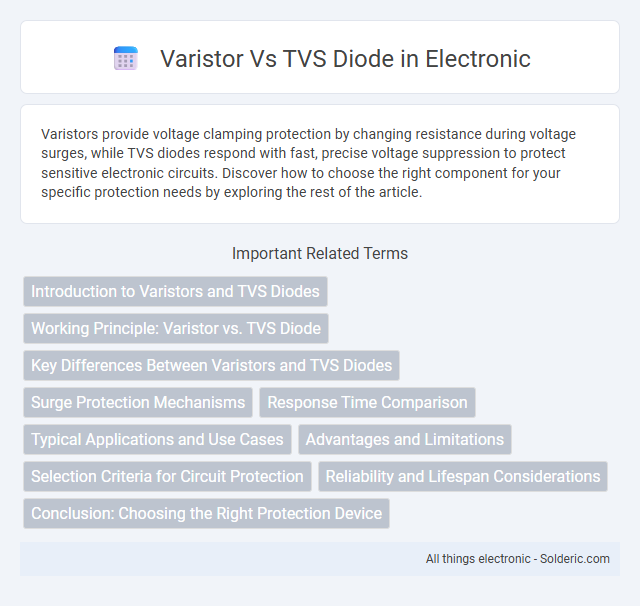Varistors provide voltage clamping protection by changing resistance during voltage surges, while TVS diodes respond with fast, precise voltage suppression to protect sensitive electronic circuits. Discover how to choose the right component for your specific protection needs by exploring the rest of the article.
Comparison Table
| Feature | Varistor (MOV) | TVS Diode |
|---|---|---|
| Function | Overvoltage protection by clamping transient surges | Fast response transient voltage suppression |
| Response Time | Microseconds to milliseconds | Picoseconds to nanoseconds |
| Clamping Voltage | Higher clamp voltage, varies with current | Low and precise clamping voltage |
| Energy Absorption | High energy absorption capability | Moderate energy absorption |
| Leakage Current | Higher leakage current | Very low leakage current |
| Typical Applications | Power supplies, AC mains protection | Data lines, sensitive electronic circuits |
| Lifespan | Degrades after multiple surge events | Longer lifespan under surge conditions |
Introduction to Varistors and TVS Diodes
Varistors and TVS diodes are essential components for protecting electronic circuits from voltage spikes and transient surges. Varistors, typically made from metal oxide, exhibit nonlinear resistance that changes with voltage, absorbing high-energy surges to prevent damage. TVS diodes respond rapidly to voltage transients by clamping voltage to a safe level, making them ideal for protecting sensitive devices in your circuit.
Working Principle: Varistor vs. TVS Diode
Varistors operate by changing their resistance in response to voltage changes, clamping excess voltage by increasing conductivity during surges. TVS diodes function through rapid voltage clamping by switching from a non-conductive to a conductive state when voltage exceeds a specific threshold, effectively shunting transient spikes. Understanding these distinct working principles helps optimize your device's protection against voltage spikes in different applications.
Key Differences Between Varistors and TVS Diodes
Varistors are voltage-dependent resistors primarily used to absorb high-energy transient voltage spikes by changing resistance, whereas TVS diodes are semiconductor devices designed to clamp voltage quickly and protect sensitive electronics from fast transient surges. Varistors typically handle higher energy pulses with slower response times, while TVS diodes offer faster response and lower clamping voltages for precise surge protection. The choice between varistors and TVS diodes depends on the application's surge energy level, response speed, and voltage clamping requirements.
Surge Protection Mechanisms
Varistors and TVS diodes provide surge protection by clamping voltage spikes to safe levels, preventing damage to electronic circuits. Varistors operate by exhibiting nonlinear resistance that decreases with increasing voltage, effectively shunting excess energy during transient surges. Your choice between these components depends on the required response time and energy absorption capacity, with TVS diodes offering faster response for high-speed circuits and varistors handling larger energy surges.
Response Time Comparison
Varistors typically have a response time in the range of microseconds to milliseconds, making them suitable for absorbing high-energy surges but slower in reaction compared to TVS diodes. TVS (Transient Voltage Suppression) diodes exhibit response times in the picosecond to nanosecond range, providing near-instantaneous clamping of transient voltage spikes. This rapid response time makes TVS diodes more effective for protecting sensitive electronic components against fast voltage transients.
Typical Applications and Use Cases
Varistors excel in protecting AC power lines and surge suppression in household appliances, industrial equipment, and power supplies due to their voltage-dependent resistance characteristics. TVS diodes are widely used for sensitive electronic circuits, automotive electronics, and data line protection, offering fast response times to transient voltage spikes. Varistors typically handle high-energy surges, while TVS diodes provide precise clamping for low-energy transient events.
Advantages and Limitations
Varistors offer high energy absorption capacity and are ideal for suppressing high-voltage transients in power circuits but have slower response times compared to TVS diodes. TVS diodes provide rapid clamping of voltage spikes with precise voltage protection, ensuring sensitive electronic components remain safe, though they typically handle less energy than varistors. Your choice depends on the specific application's requirement for energy absorption versus response speed and precision.
Selection Criteria for Circuit Protection
Varistors offer effective protection against high-energy surges by clamping voltage spikes with non-linear resistance, making them ideal for applications with large transient currents and wide voltage ranges. TVS diodes provide precise clamping at low voltage thresholds with fast response times, suitable for sensitive electronics requiring repeated and reliable transient suppression. Selecting between varistors and TVS diodes depends on factors such as maximum transient voltage, response speed, energy absorption capacity, and the specific protection requirements of the circuit design.
Reliability and Lifespan Considerations
Varistors typically offer high surge current capacity but can degrade over time due to repeated transient events, leading to reduced reliability and shorter lifespan compared to TVS diodes. TVS diodes provide faster response times and maintain stable clamping voltage over numerous surges, ensuring consistent protection and extended operational life. For applications demanding long-term reliability and predictable lifespan, TVS diodes are often preferred over varistors.
Conclusion: Choosing the Right Protection Device
Selecting between a varistor and a TVS diode depends on the specific application requirements, such as response time, voltage clamping, and energy absorption capacity. Varistors offer high energy handling and cost-effectiveness for surge protection in power lines, while TVS diodes provide faster response times and precise voltage clamping for sensitive electronic circuits. Understanding the trade-offs in terms of durability, circuit protection level, and transient suppression ensures optimal device selection for reliable surge protection.
Varistor vs TVS Diode Infographic

 solderic.com
solderic.com